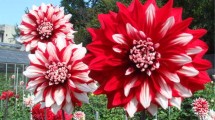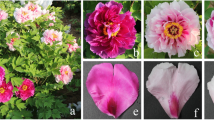Abstract
Black color in flowers is a highly attractive trait in the floricultural industry, but its underlying mechanisms are largely unknown. This study was performed to identify the bases of the high accumulation of anthocyanidins in black cultivars and to determine whether the high accumulation of total anthocyanidins alone leads to the black appearance. Our approach was to compare black dahlia (Dahlia variabilis) cultivars with purple cultivars and a purple flowering mutant of a black cultivar, using pigment and molecular analyses. Black cultivars characteristically exhibited low lightness, high petal accumulation of cyanidin and total anthocyanidins without flavones, and marked suppression of flavone synthase (DvFNS) expression. A comparative study using black and purple cultivars revealed that neither the absence of flavones nor high accumulation of total anthocyanidins is solely sufficient for black appearance, but that cyanidin content in petals is also an important factor in the phenotype. A study comparing the black cultivar ‘Kokucho’ and its purple mutant showed that suppression of DvFNS abolishes the competition between anthocyanidin and flavone synthesis and leads to accumulation of cyanidin and total anthocyanidins that produce a black appearance. Surprisingly, in black cultivars the suppression of DvFNS occurred in a post-transcriptional manner, as determined by small RNA mapping.








Similar content being viewed by others
Abbreviations
- ANS:
-
Anthocyanidin synthase
- bHLH:
-
Basic helix–loop–helix
- CHI:
-
Chalcone isomerase
- CHS:
-
Chalcone synthase
- DFR:
-
Dihydroflavonol 4-reductase
- F3H:
-
Flavanone 3-hydroxylase
- F3′H:
-
Flavonoid 3′-hydroxylase
- FLS:
-
Flavonol synthase
- FNS:
-
Flavone synthase
- GST:
-
Glutathione S-transferase
- GT:
-
Glucosyltransferase
- HPLC:
-
High performance liquid chromatography
- MT:
-
Malonyltransferase
- PTGS:
-
Post-transcriptional gene silencing
- RACE:
-
Rapid amplified cDNA end
- siRNA:
-
Short interfering RNA
References
Akashi T, Fukuchi-Mizutani M, Aoki T, Ueyama Y, Yonekura-Sakakibara K, Tanaka Y, Kusumi T, Ayabe SI (1999) Molecular cloning and biochemical characterization of a novel cytochrome P450, flavone synthase II, that catalyzes direct conversion of flavanones to flavones. Plant Cell Physiol 40:1182–1186
Azuma A, Udo Y, Sato A, Mitani N, Kono A, Ban Y, Yakushiji H, Koshita Y, Kobayashi S (2011) Haplotype composition at the color locus is a major genetic determinant of skin color variation in Vitis × labruscana grapes. Theor Appl Genet 122:1427–1438
Davies KM, Schwinn KE, Deroles SC, Manson DG, Lewis DH, Bloor SJ, Bradley JM (2003) Enhancing anthocyanin production by altering competition for substrate between flavonol synthase and dihydroflavonol 4-reductase. Euphytica 131:259–268
De Paoli E, Dorantes-Acosta A, Zhai J, Accerbi M, Jeong DH, Park S, Meyers BC, Jorgensen RA, Green PJ (2009) Distinct extremely abundant siRNAs associated with cosuppression in petunia. RNA 15:1965–1970
Fliegmann J, Furtwängler K, Malterer G, Cantarello C, Schüler G, Ebel J, Mithöfer A (2010) Flavone synthase II (CYP93B16) from soybean (Glycine max L.). Phytochemistry 71:508–514
Gatt M, Ding H, Hammett K, Murray B (1998) Polyploidy and evolution in wild and cultivated Dahlia species. Ann Bot 81:647–656
Ghildiyal M, Zamore PD (2009) Small silencing RNAs: an expanding universe. Nat Rev Gen 10:94–108
Grotewold E (2006) The genetics and biochemistry of floral pigments. Annu Rev Plant Biol 57:761–780
Hamilton A, Voinnet O, Chappell L, Baulcombe D (2002) Two classes of short interfering RNA in RNA silencing. EMBO J 21:4671–4679
Harborne JB, Greenham J, Eagles J (1990) Malonylated chalcone glycosides in Dahlia. Phytochemistry 29:2899–2900
Hichri I, Barrieu F, Bogs J, Kappel C, Delrot S, Lauvergeat V (2011) Recent advances in the transcriptional regulation of the flavonoid biosynthetic pathway. J Exp Bot 62:2465–2483
Holton TA, Brugliera F, Tanaka Y (1993) Cloning and expression of flavonol synthase from Petunia hybrida. Plant J 4:1003–1010
Kitamura S, Shikazono N, Tanaka A (2004) TRANSPARENT TESTA 19 is involved in the accumulation of both anthocyanins and proanthocyanidins in Arabidopsis. Plant J 37:104–114
Kobayashi S (2009) Regulation of anthocyanin biosynthesis in grapes. J Jpn Soc Hortic Sci 78:387–393
Kobayashi S, Ishimaru M, Hiraoka K, Honda C (2002) Myb-related genes of the Kyoho grape (Vitis labruscana) regulate anthocyanin biosynthesis. Planta 215:924–933
Kobayashi S, Goto-Yamamoto N, Hirochika H (2005) Association of VvmybA1 gene expression with anthocyanin production in grape (Vitis vinifera) skin-color mutants. J Jpn Soc Hortic Sci 74:196–203
Koes R, Verweij W, Quattrocchio F (2005) Flavonoids: a colorful model for the regulation and evolution of biochemical pathways. Trends Plant Sci 10:236–242
Kurauchi T, Matsumoto T, Taneda A, Sano T, Senda M (2009) Endogenous short interfering RNAs of chalcone synthase genes associated with inhibition of seed coat pigmentation in soybean. Breed Sci 59:419–426
Lawrence WJC (1929) The genetics and cytology of Dahlia species. J Genet 21:125–159
Lawrence WJC (1931) The genetics and cytology of Dahlia variabilis. J Genet 24:257–306
Lawrence WJC, Scott-Honcrieff R (1935) The genetics and chemistry of flower colour in dahlia: a new theory of specific pigmentation. J Genet 30:155–226
Mahajan M, Ahuja PS, Yadav SK (2011) Post-transcriptional silencing of flavonol synthase mRNA in tobacco leads to fruits with arrested seed set. PLoS One 6:e28315
Martens S, Forkmann G (1998) Genetic control of flavone synthase II activity in flowers of Gerbera hybrids. Phytochemistry 49:1953–1958
Martens S, Forkmann G (1999) Cloning and expression of flavone synthase II from Gerbera hybrids. Plant J 20:611–618
Martens S, Mithöfer A (2005) Flavones and flavone synthases. Phytochemistry 66:2399–2407
McClaren M (2009) Dahlia: history and species. In: McClaren B (ed) Encyclopedia of dahlias. Timber Press, Portland, pp 161–166
Morita Y, Saito R, Ban Y, Tanikawa N, Kuchitsu K, Ando T, Yoshikawa M, Habu Y, Ozeki Y, Nakayama M (2012) Tandemly arranged chalcone synthase A genes contribute to the spatially regulated expression of siRNA and the natural bicolor floral phenotype in Petunia hybrida. Plant J 70:739–749
Mueller LA, Goodman CD, Silady RA, Walbot V (2000) AN9, a petunia glutathione S-transferase required for anthocyanin sequestration, is a flavonoid-binding protein. Plant Physiol 123:1561–1570
Nakatsuka T, Nishihara M, Mishiba K, Yamamura S (2005) Temporal expression of flavonoid biosynthesis-related genes regulates flower pigmentation in gentian plants. Plant Sci 168:1309–1318
Nesi N, Debeaujon I, Jond C, Pelletier G, Caboche M, Lepiniec L (2000) The TT8 gene encodes a basic helix–loop–helix domain protein required for expression of DFR and BAN genes in Arabidopsis siliques. Plant Cell 12:1863–1878
Nielsen K, Deroles SC, Markham KR, Bradley MJ, Podivinsky E, Manson D (2002) Antisense flavonol synthase alters copigmentation and flower color in lisianthus. Mol Breed 9:217–229
Nordström CG, Swain T (1953) The flavonoid glycosides of Dahlia variabilis. Part I. General introduction cyanidin, apigenin, and luteolin glycosides from the variety “Dandy”. J Chem Soc 2764–2773
Ohno S, Hosokawa M, Hoshino A, Kitamura Y, Morita Y, Park KI, Nakashima A, Deguchi A, Tatsuzawa F, Doi M, Iida S, Yazawa S (2011a) A bHLH transcription factor, DvIVS, is involved in regulation of anthocyanin synthesis in dahlia (Dahlia variabilis). J Exp Bot 62:5105–5116
Ohno S, Deguchi A, Hosokawa M, Tatsuzawa F, Doi M (2011b) Accumulation of flavonoid pigments characteristic of blackish Dahlia petals. Hortic Res 10(Suppl. 2):564 (In Japanese)
Ohno S, Hosokawa M, Kojima M, Kitamura Y, Hoshino A, Tatsuzawa F, Doi M, Yazawa S (2011c) Simultaneous post-transcriptional gene silencing of two different chalcone synthase genes resulting in pure white flowers in the octoploid dahlia. Planta 234:945–958
Price JR (1939) The yellow colouring matter of Dahlia variabilis. J Chem Soc 1017–1018
Saito N, Mikanagi Y (1989) Sekishokushikiso to sekishokuka. Bio Hortic 3:49–62 (In Japanese)
Spelt C, Quattrocchio F, Mol JNM, Koes R (2000) Anthocyanin1 of petunia encodes a basic helix–loop–helix protein that directly activates transcription of structural anthocyanin genes. Plant Cell 12:1619–1631
Takeda K, Harborne JB, Self R (1986) Identification and distribution of malonated anthocyanins in plants of the compositae. Phytochemistry 25:1337–1342
Tanaka Y, Sasaki N, Ohmiya A (2008) Biosynthesis of plant pigments: anthocyanins, betalains and carotenoids. Plant J 54:733–749
Thill J, Miosic S, Ahmed R, Schlangen K, Muster G, Stich K, Halbwirth H (2012) ‘Le Rouge et le Noir’: a decline in flavone formation correlates with the rare color of black dahlia (Dahlia variabilis hort.) flowers. BMC Plant Biol 12:225
Tuteja JH, Zabala G, Varala K, Hudson M, Vodkin LO (2009) Endogenous, tissue-specific short interfering RNAs silence the chalcone synthase gene family in Glycine max seed coats. Plant Cell 21:3063–3077
Ueyama Y, Suzuki KI, Fukuchi-Mizutani M, Fukui Y, Miyazaki K, Ohkawa H, Kusumi T, Tanaka Y (2002) Molecular and biochemical characterization of torenia flavonoid 3′-hydroxylase and flavone synthase II and modification of flower color by modulating the expression of these genes. Plant Sci 163:253–263
Acknowledgments
We thank Yukihiro Fukuda for providing the ‘Kokucho’ mutant line.
Author information
Authors and Affiliations
Corresponding authors
Electronic supplementary material
Below is the link to the electronic supplementary material.
Rights and permissions
About this article
Cite this article
Deguchi, A., Ohno, S., Hosokawa, M. et al. Endogenous post-transcriptional gene silencing of flavone synthase resulting in high accumulation of anthocyanins in black dahlia cultivars. Planta 237, 1325–1335 (2013). https://doi.org/10.1007/s00425-013-1848-6
Received:
Accepted:
Published:
Issue Date:
DOI: https://doi.org/10.1007/s00425-013-1848-6




